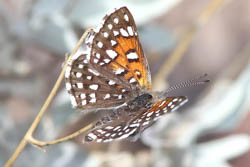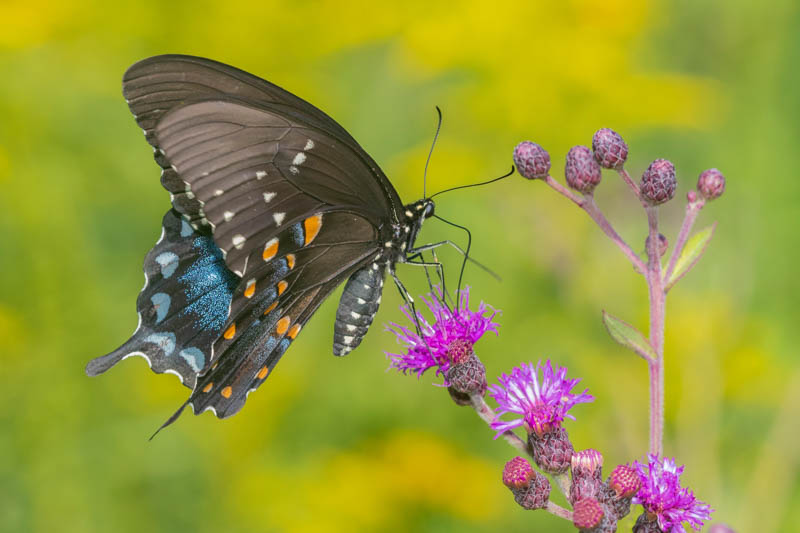By providing nectar-rich flowers and habitat, you'll attract and support butterflies, enhancing your garden's charm and contributing to pollinator conservation.
Creating a butterfly garden is more than just making your yard look beautiful. It’s about helping butterflies, which are losing their natural habitats. Plus, they help other plants in your garden by pollinating them. Butterfly gardens are also great for learning about nature and can make you feel more relaxed just by watching these beautiful creatures.
Many butterfly populations are declining due to habitat loss and pollution. By creating butterfly gardens, we offer them a sanctuary to feed, breed, and thrive. Here are a few notable examples of butterfly species facing population declines:
 |
Monarch Butterfly (Danaus plexippus)
Magnificent with its orange wings laced with black lines and bordered with white dots, the Monarch butterfly is in trouble. Its population in North America has plummeted by 90% in the last 20 years. Among the reasons for this decline are habitat loss and degradation, loss of milkweed plants, which are essential for their larvae, extensive herbicide use, and climate change. |
 |
Karner Blue Butterfly (Lycaeides melissa samuelis)
The Karner Blue Butterfly, a small, distinctive butterfly found in North America, has experienced a significant decline in its population. Once widespread across the northeastern United States, its numbers have dwindled drastically, leading to its classification as an endangered species. The primary cause of this decline is habitat loss, especially the disappearance of wild lupine, the sole food source for its caterpillars. Additionally, factors like urban development, forest succession, and fire suppression have contributed to the loss of its pine-oak barrens and savanna habitats. |
 |
Mormon Metalmark (Apodemia mormo)
The Mormon Metalmark butterfly, native to North America, particularly the western regions, has faced a notable decline in its population. This decline is primarily attributed to habitat loss and fragmentation. The butterfly relies on specific environments, such as riverine systems and arid lands with an abundance of buckwheat plants, which are crucial for the survival of its larvae. Urban expansion, agricultural development, and changes in land management practices have significantly reduced these habitats, posing a serious threat to the species’ survival. |
 |
Swallowtail Butterflies (Family Papilionidae)
Swallowtail butterflies, a diverse group known for their large size and striking colors, have seen varied declines in different regions. Factors contributing to their population decrease include habitat loss, climate change, and pesticide use. In particular, urbanization and agricultural expansion have led to the destruction of larval host plants, like milkweed and wild fennel. Additionally, climate change-induced weather fluctuations affect their breeding and migration patterns. Conservation efforts are crucial to address these challenges and protect the diverse species within the swallowtail family. |
Butterfly pollination is an important aspect of biodiversity and ecosystem health. While bees are often considered the most important pollinators due to their abundance and efficiency, butterflies also play a crucial role in pollination, albeit in different ways. Here’s why butterfly pollination is important:

Butterfly gardens are not just areas of natural beauty. They function as dynamic outdoor classrooms for both children and adults. In these spaces, visitors can observe the fascinating life cycle of butterflies firsthand – from eggs to caterpillars, then chrysalises, and finally, emerging adults.
Such gardens offer tangible lessons on metamorphosis, an essential concept in understanding biological processes.
Additionally, they highlight the critical role butterflies play in ecosystems, particularly in pollination and serving as indicators of environmental health. Engaging with butterfly gardens can foster a deeper appreciation for nature, encouraging ecological stewardship and a greater understanding of biodiversity and its importance.
 Monarch Trinity: Chrysalis, caterpillar and butterfly on milkweed
Monarch Trinity: Chrysalis, caterpillar and butterfly on milkweed
A garden designed to attract butterflies extends its benefits far beyond these colorful insects. Such a garden becomes a haven for a myriad of beneficial insects like bees, hoverflies, and ladybugs, all playing crucial roles in pollination and pest control.
Additionally, it attracts a variety of birds, drawn by both the insects and the native plant species. This diversity of flora and fauna enriches the garden’s ecological fabric, contributing to a richer, more balanced ecosystem.
By supporting this variety of life, a butterfly garden enhances the local biodiversity, making it a vital cog in sustaining the health and balance of the surrounding environment.

A Wild Robin (Erithacus rubecula) Watching a Monarch Butterfly
The presence of butterflies, with their graceful flight and vivid colors, alongside the calming practice of gardening, creates a serene atmosphere that can have profound therapeutic effects. Engaging in butterfly gardening involves nurturing plants, observing delicate life cycles, and immersing oneself in nature’s rhythms, all of which are activities known to reduce stress and enhance mental well-being.
The tranquility of watching butterflies flutter and alight on flowers offers a unique form of natural therapy, fostering a sense of peace and connection to the natural world. This harmonious interaction with nature not only revitalizes the garden but also rejuvenates the gardener, contributing to overall emotional and mental health.
 Pipevine Swallowtails (Battus philenor) on Butterfly Milkweed (Asclepias tuberosa)
Pipevine Swallowtails (Battus philenor) on Butterfly Milkweed (Asclepias tuberosa)
Butterflies add beauty and interest to your garden with their graceful movements and vibrant colors, enhancing the enjoyment of your outdoor space.
 Spicebush Swallowtail (Papilio troilus) on Missouri Ironweed (Vernonia missurica)
Spicebush Swallowtail (Papilio troilus) on Missouri Ironweed (Vernonia missurica)
| Genus | Vernonia, Solidago, Tagetes, Syringa, Phlox, Zinnia, Salvia, Rudbeckia, Pulmonaria, Sedum, Helenium, Nepeta, Monarda, Lobularia, Achillea, Pentas, Lavandula, Hemerocallis, Liatris, Echinops, Eryngium, Cosmos, Coreopsis, Echinacea, Cercis, Calendula, Aster, Amelanchier, Alcea, Allium, Asclepias, Agastache, Ageratum |
|---|---|
| Attracts | Butterflies |
| Genus | Vernonia, Solidago, Tagetes, Syringa, Phlox, Zinnia, Salvia, Rudbeckia, Pulmonaria, Sedum, Helenium, Nepeta, Monarda, Lobularia, Achillea, Pentas, Lavandula, Hemerocallis, Liatris, Echinops, Eryngium, Cosmos, Coreopsis, Echinacea, Cercis, Calendula, Aster, Amelanchier, Alcea, Allium, Asclepias, Agastache, Ageratum |
|---|---|
| Attracts | Butterflies |
Create a membership account to save your garden designs and to view them on any device.
Becoming a contributing member of Gardenia is easy and can be done in just a few minutes. If you provide us with your name, email address and the payment of a modest $25 annual membership fee, you will become a full member, enabling you to design and save up to 25 of your garden design ideas.
Join now and start creating your dream garden!
Create a membership account to save your garden designs and to view them on any device.
Becoming a contributing member of Gardenia is easy and can be done in just a few minutes. If you provide us with your name, email address and the payment of a modest $25 annual membership fee, you will become a full member, enabling you to design and save up to 25 of your garden design ideas.
Join now and start creating your dream garden!